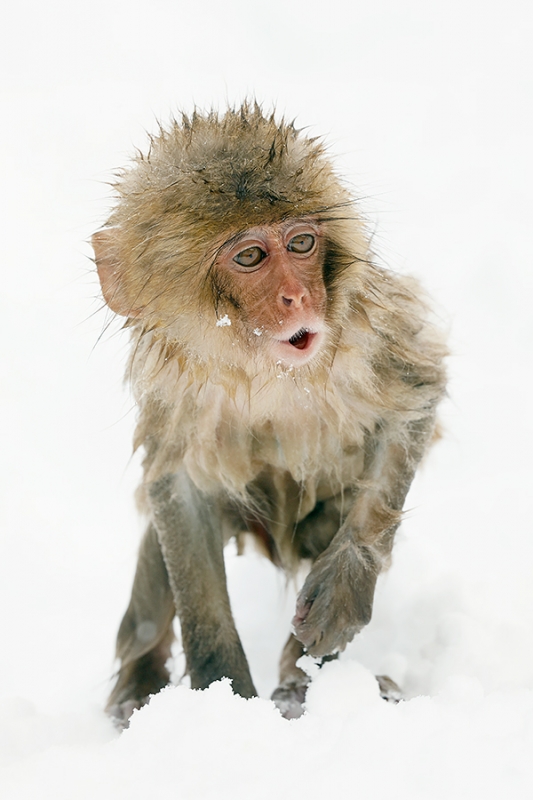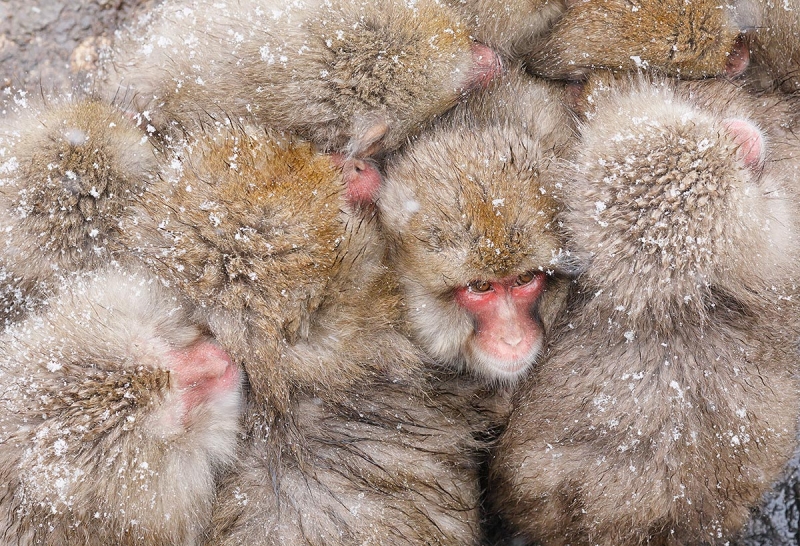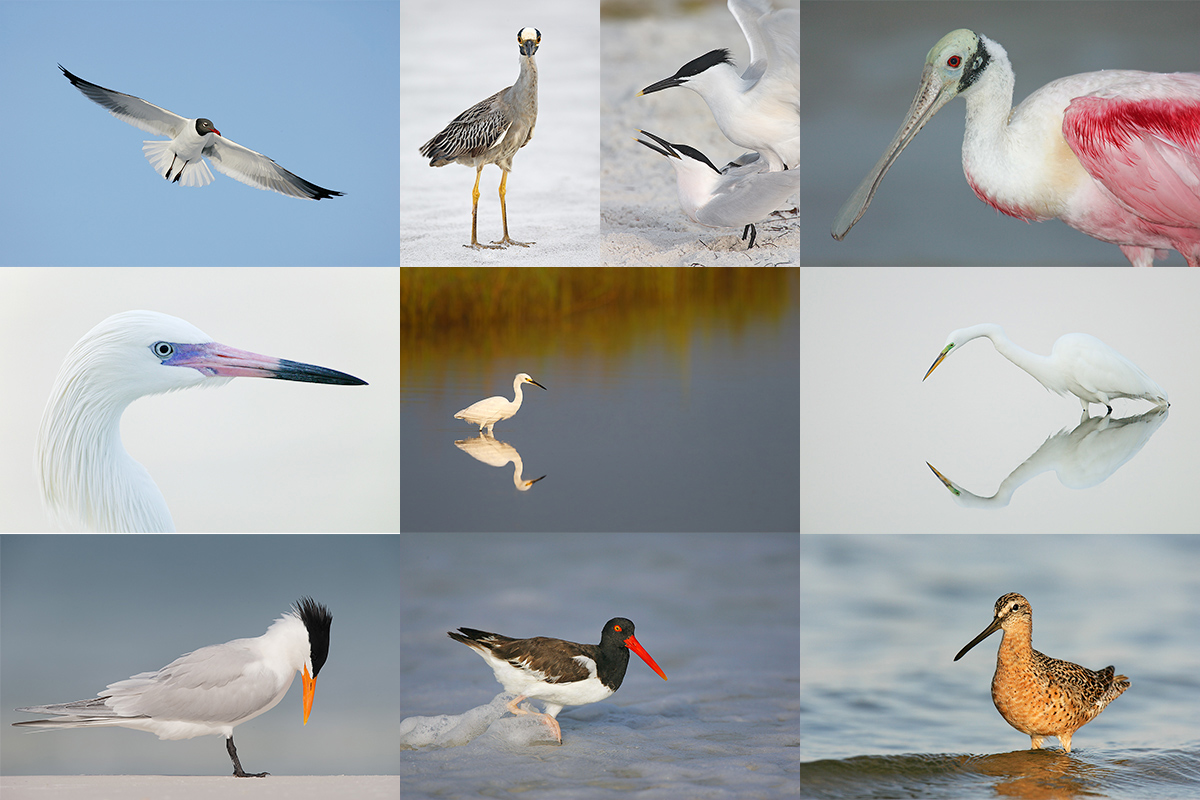What’s Up?
Patrick Sparkman and I celebrated the 2nd day after St. Patrick’s Day by photographing all morning at La Jolla. When we moved down to the low cliffs I grabbed the 100mm f/2.8L IS Macro lens and did some flowers while Patrick worked some Least Sandpipers with his 600 II. As I made this trip with only my 100-400 II and the TC, I am looking forward to borrowing Patrick’s 600 II on Monday and Tuesday. Along with both TCs, a 12mm tube, and the tripod/Mongoose M3.6 setup that he rarely uses :). Gonna try to get that hummingbird …
Gear Questions and Advice
Too many folks attending BAA IPTs and dozens of folks whom I see in the field, and on BPN, are–out of ignorance–using the wrong gear, especially when it comes to tripods and more especially, tripod heads… Please know that I am always glad to answer your gear questions via e-mail.
The Streak: 4!
Today’s blog post marks a totally insane, irrational, illogical, preposterous, absurd, completely ridiculous, unfathomable, silly, incomprehensible, what’s wrong with this guy?, makes-no-sense, 4 days in a row with a new educational blog post. As always–and folks have been doing a really great for a long time now–please remember to use our B&H links for your major gear purchases. For best results use one of our many product-specific links; after clicking on one of those you can continue shopping with all subsequent purchases invisibly tracked to BAA. Your doing so is always greatly appreciated. Please remember: web orders only. And please remember also that if you are shopping for items that we carry in the BAA Online Store (as noted in red at the close of this post below) we would of course appreciate your business.
|
|
|
This image was created at the Monkey Park at Jigokudani, Japan with the Canon EF 100-400mm f/4.5-5.6L IS II USM lens (at 400m) and my very favorite camera body, the Canon EOS 5D Mark IV. ISO 1600. Evaluative metering +2 stops: 1/800 sec. at f/8 in Manual mode was about 2/3 stop under. AWB. LensAlign/FocusTune micro-adjustment: +3. One AF point up and one to the left of the center AF point/AI Servo/Expand/Shutter Button AF was active at the moment of exposure. The active AF point fell on a spot just to our left and below the monkey’s right eye. Image #1: Young Snow Monkey whistling |
The Monkey Park Follow-Up
Thanks to the many who commented; by the time this is published, I will have responded to most of the comments on the original blog post here. Yes, photographing at the Monkey Park is a bit like photographing in a zoo or a game farm. The only difference is that the Monkey Park does not have fences around it to enclose the animals. (I might be wrong about that …) I believe that the Monkey Park was created to protect the Snow Monkeys from being killed en masse for eating cultivated fruits in the area. In the mornings the monkeys are whistled down from the surrounding hillsides to be fed. They always come down, usually quite quickly. And yes, as you saw in the original post, it can get crowded around the main monkey onsen. But as a few folks mentioned, by getting there early and staying late, you can enjoy less crowded conditions.
Option I
And while the main monkey onsen can get quite crowded at times, the level of crowding often fluctuates as the tour busses come and go with folks having to make a fairly strenuous 30+ minute hike up the hill. When it is very crowded, the easiest thing to do is to photograph the monkeys on the hillside just behind the main onsen. As you can see in today’s first featured image immediately above, these animals are often quite close and are often at your eye level. And I have never seen this area so crowded as to prevent comfortable shooting. Solitude? Not by any means.
While there are surely some sites in present-day Japan where you might be able to get an image or two of this species by spending a ton of time and/or by making a huge physical investment, photography at the Monkey Park is relatively easy after you make the hike up. And the subjects are endearing. I have always enjoyed photographing there.
|
|
|
This image was created at the Monkey Park at Jigokudani, Japan with the Canon EF 100-400mm f/4.5-5.6L IS II USM lens (at 176mm) and my very favorite camera body, the Canon EOS 5D Mark IV. ISO 1600. Evaluative metering +1 1/3 stops: 1/200 sec. at f/9 in Manual mode. AWB. LensAlign/FocusTune micro-adjustment: +3. One AF point down and two to the right of the center AF point/AI Servo/Expand/Shutter Button AF was active at the moment of exposure. The active AF point fell right on the bridge of the nose of the main subject monkey. Image #2: A Pile of Snow Monkeys |
Option II is More Fun Than a Pile of Monkeys
The second option is simply to take a walk away from the main onsen. There is almost always lots of room along the pathways and down by the river. And though many areas have been placed off limits to visitors, patient folks who are willing to explore just a tiny bit will encounter dozens of great photographic opportunities. My 2016 co-leader Paul McKenzie took a walk down to the river, discovered this pile of monkeys, and kindly notified the group. Rather than heading all the way down to the river I first opted to photograph the pile from the ramp that was about 15 feet above them. What fun.
Folks who opt never to photograph in crowded conditions are free of course to make that choice. I on the other hand have always enjoyed being around lots of people. It is possible that I might be the only living nature photographer who would prefer to be on a wild beach with six other photographers than to be there alone. And that would be true whether or not they are paying clients.
In Addition …
Folks go to Japan in winter for four main reasons: to photograph the Snow Monkeys, to photograph the sea-eagles, to photograph the Red-crowned Cranes, and to photograph the Whooper Swans. As with the monkeys, the other three situations are anything but natural. The sea eagles are attracted for viewing and photography with tossed frozen fish. The cranes are fed corn at two primary photo locations. And at Lake Kussharo, the swans also gather in numbers to be fed by humans.
Again, I have always enjoyed photographing the aforementioned birds just as I have enjoyed photographing the monkeys. Do not forget that images of the monkeys, the sea eagles, the cranes, and the swans are consistently honored in the major photographic competitions … If you would like to go, I believe that Denise Ippolito is going next year (with Paul McKenzie as co-leader) and probably beyond that. Check out her blog for details. She remains the most creative photographer that I know and is an extremely hard working and skilled leader as well.
|
DeSoto in spring is rife with tame and attractive birds. From upper left clockwise to center: breeding plumage Dunlin, dark morph breeding plumage Reddish Egret displaying, breeding plumage Laughing Gull/front end vertical portrait, breeding plumage Laughing Gull with prey item, Laughing Gull on head of Brown Pelican, screaming Royal Tern in breeding plumage, Royal Terns/pre-copulatory stand, Laughing Gulls copulating, breeding plumage Laughing Gull/tight horizontal portrait, Sandwich Tern with fish, and a really rare one, White-rumped Sandpiper in breeding plumage, photographed at DeSoto in early May. |
Fort DeSoto Spring IPT/April 19-22, 2017. (meet & greet at 2pm on Wednesday April 19 followed by an afternoon session) through the full day on Saturday April 22. 3 1/2 DAYs: $1599. Limit 10/Openings 4. To save your spot, please call and put down a non-refundable deposit of $499.00.
I will be offering small group (Limit 3) Photoshop sessions on Sunday afternoon and Monday morning if necessary. Details on that TBA.
Fort DeSoto is one of the rare locations that might offer great bird photography 365 days a year. It shines in spring. There will Lots of tame birds including breeding plumage Laughing Gull and Royal and Sandwich Terns. With luck, we will get to photograph all of these species courting and copulating. There will be American Oystercatcher and Marbled Godwit plus sandpipers and plovers, some in full breeding plumage. Black-bellied Plover and Red Knot in stunning breeding plumage are possible. There will be lots of wading birds including Great and Snowy Egrets, both color morphs of Reddish Egret, Great Blue, Tricolored and Little Blue Heron, Yellow-crowned Night-Heron, and killer breeding plumage White Ibis. Roseate Spoonbill and Wood Stork are possible and likely. We should have lots of good flight photography with the gulls and terns and with Brown Pelican. Nesting Least Tern and nesting Wilson’s Plover are possible.
We will, weather permitting, enjoy 7 shooting sessions. As above, our first afternoon session will follow the meet and greet at 2pm on Wednesday April 19. For the next three days we will have two daily photo sessions. We will be on the beach early and usually be at lunch (included) by 11am. We will have three indoor sessions. At one we will review my images–folks learn a ton watching me choose my keepers and deletes–why keep this one and delete that one? The second will be a review of your images so that I can quickly learn where you need help. For those who bring their laptops to lunch I’d be glad to take a peek at an image or three. Day three will be a Photoshop session during which we will review my complete workflow and process an image or two in Photoshop after converting them in DPP. Afternoon sessions will generally run from 4:30pm till sunset. We photograph until sunset on the last day, Saturday, April 22. Please note that this is a get-your-feet and get-your-butt wet and sandy IPT. And that you can actually do the whole IPT with a 300 f/2.8L IS, a 400 f/4 ID DO lens with both TCs, or the equivalent Nikon gear. I will surely be using my 500 II as my big glass and have my 100-400 II on my shoulder.
|
DeSoto in spring is rife with tame and attractive birds. From upper left clockwise to center: Laughing Gull in flight, adult Yellow-crowned Night-Heron, copulating Sandwich Terns, Roseate Spoonbill, Great Egret with reflection, Short-billed Dowitcher in breeding plumage, American Oystercatcher, breeding plumage Royal Tern, white morph Reddish Egret, and Snowy Egret marsh habitat shot. |
What You Will Learn
You will learn to approach free and wild birds without disturbing them, to understand and predict bird behavior, to identify many species of shorebirds, to spot the good situations, to understand the effects of sky and wind conditions on bird photography, to choose the best perspective, to see and understand the light, to get the right exposure every time after making a single test exposure, and to design pleasing images by mastering your camera’s AF system. And you will learn how and why to work in Manual mode (even if you are scared of it).
The group will be staying at the Red Roof Inn, St. Petersburg: 4999 34th St. North, St Petersburg, FL 33714. The place is clean and quite inexpensive. Please e-mail for room block information. And please call Jim or Jennifer at 863-692-0906 to register. All will need to purchase an Annual Pass early on Tuesday afternoon so that we can enter the park at 6am and be in position for sunrise opportunities. The cost is $75, Seniors $55. Tight carpools will be needed and will reduce the per person Annual Pass costs. The cost of three lunches is included. Breakfasts are grab what you can on the go, and dinners are also on your own due to the fact that we will usually be getting back to the hotel at about 9pm. Non-photographer spouses, friends, or companions are welcome for $100/day, $350 for the whole IPT.
BIRDS AS ART Fort DeSoto In-the-Field Meet-up Workshop (ITFW): $99
Fort DeSoto Spring In-the-Field Cheap Meet-up Workshop (ITFW) on the morning of Sunday, April 23, 2017: $99
Join me on the morning of Sunday April 23, 2017 for 3-hours of photographic instruction at Fort DeSoto Park. Beginners are welcome. Lenses of 300mm or longer are recommended but even those with 70-200s should get to make some nice images. Teleconverters are always a plus.
You will learn the basics of digital exposure and image design, autofocus basics, and how to get close to free and wild birds. We should get to photograph a variety of wading birds, shorebirds, terns, and gulls. This inexpensive morning workshop is designed to give folks a taste of the level and the quality of instruction that is provided on BIRDS AS ART Instructional Photo-tours. I hope to meet you there.
To register please call Jim or Jennifer during weekday business hours with a credit card in hand to pay the nominal registration fee. Your registration fee is non-refundable. You will receive a short e-mail with instructions, gear advice, and meeting place one week before the event.


Please Remember to use my Affiliate Links and to Visit the New BAA Online Store 🙂
To show your appreciation for my continuing efforts here, we ask, as always, that you get in the habit of using my B&H affiliate links on the right side of the blog for all of your photo and electronics purchases. Please check the availability of all photographic accessories in the New BIRDS AS ART Online Store, especially the Mongoose M3.6 tripod head, Wimberley lens plates, Delkin flash cards and accessories, and LensCoat stuff.
As always, we sell only what I have used, have tested, and can depend on. We will not sell you junk. We know what you need to make creating great images easy and fun. And please remember that I am always glad to answer your gear questions via e-mail.
I would of course appreciate your using our B&H affiliate links for all of your major gear, video, and electronic purchases. For the photographic stuff mentioned in the paragraph above, and for everything else in the new store, we, meaning BAA, would of course greatly appreciate your business. Here is a huge thank you to the many who have been using our links on a regular basis and those who will be visiting the New BIRDS AS ART Online Store as well.
Be sure to like and follow BAA on Facebook by clicking on the logo link upper right. Tanks a stack.
Typos
In all blog posts and Bulletins, feel free to e-mail or to leave a comment regarding any typos or errors. Just be right :).


















I really dig Image #2: “A Pile of Snow Monkeys.” I’ve never seen them in such a pose. The detail of the fur and bits of snow give a lot of texture to the image.